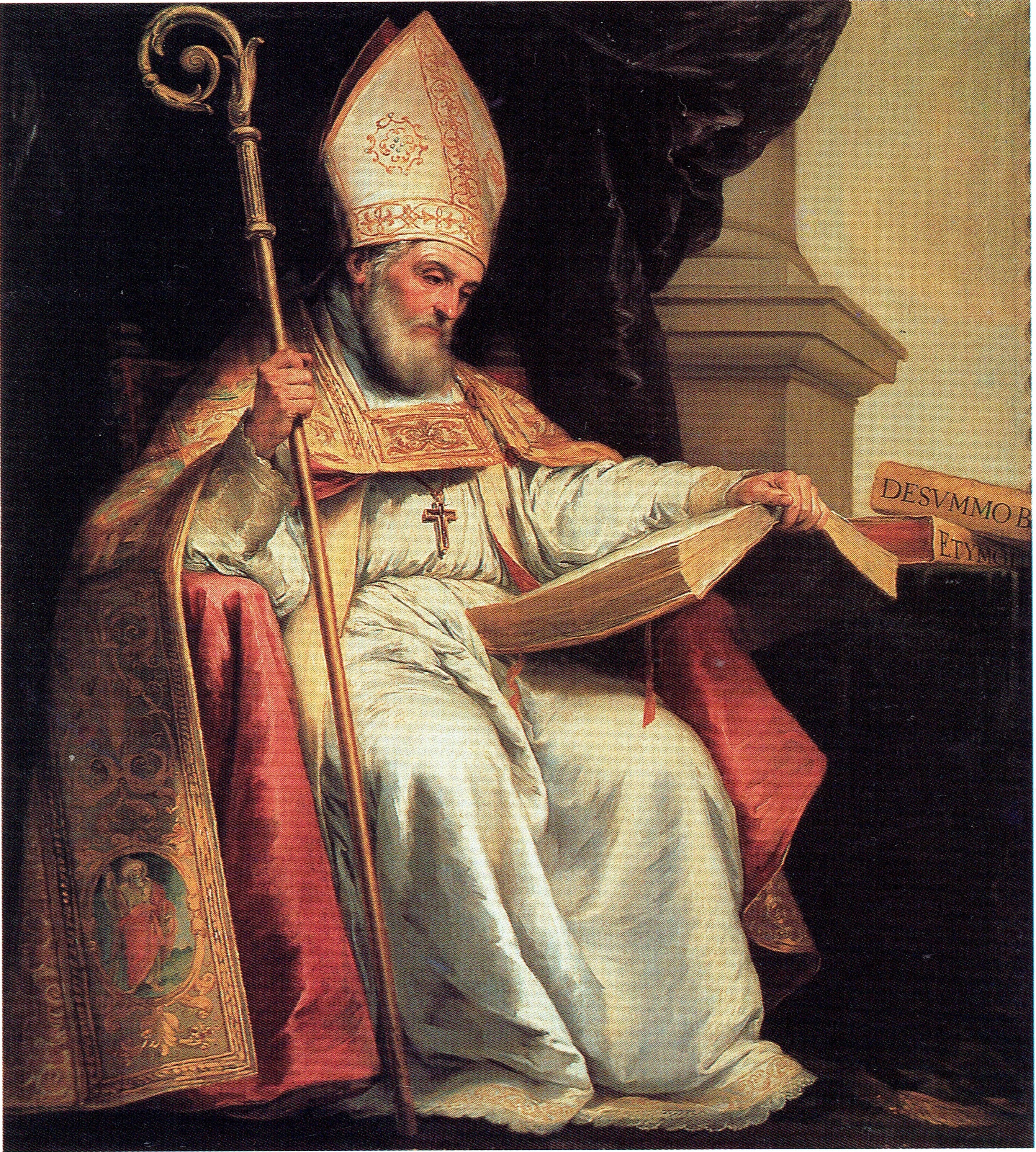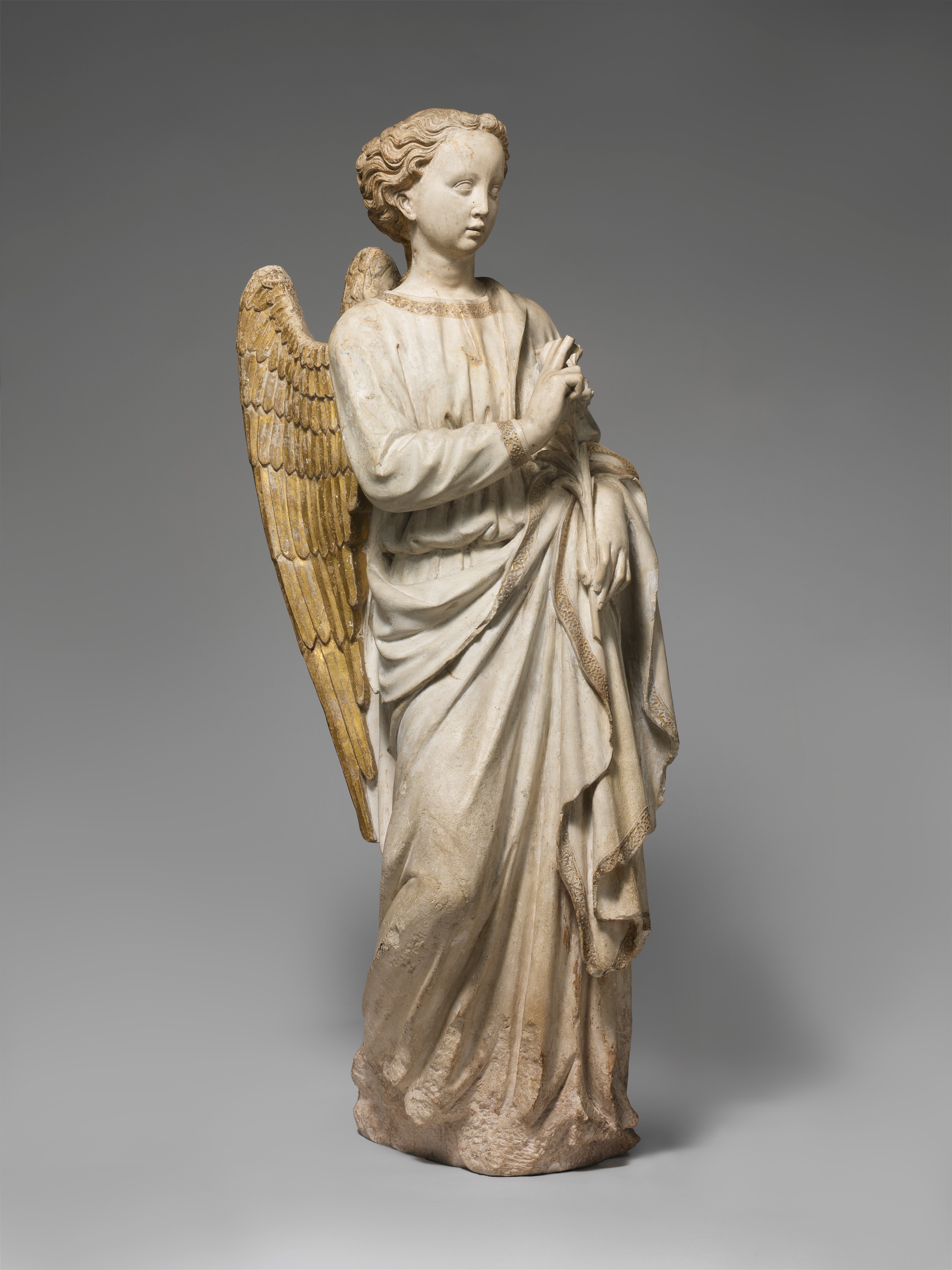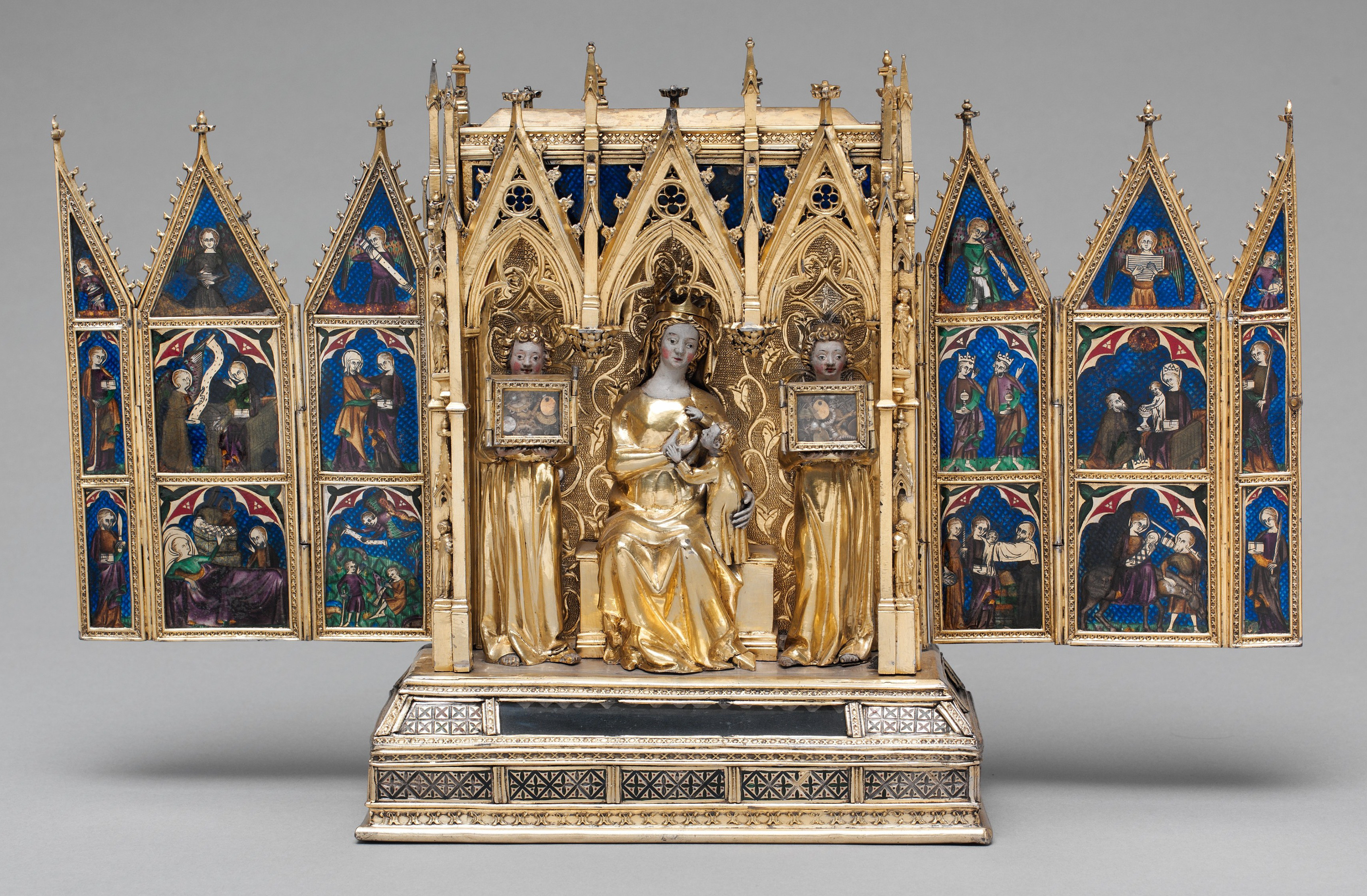|
Chair Of St. Peter
The Chair of Saint Peter (), also known as the Throne of Saint Peter, is a relic conserved in St. Peter's Basilica in Vatican City, the sovereign enclave of the Pope inside Rome, Italy. The relic is a wooden throne that tradition claims belonged to the Apostle Saint Peter, the leader of the Early Christians in Rome and first Pope, and which he used as Bishop of Rome. The relic is enclosed in a sculpted gilt bronze casing designed by Gian Lorenzo Bernini and constructed between 1647 and 1653. In 2012, Pope Benedict XVI described the chair as "a symbol of the special mission of Peter and his Successors to tend Christ's flock, keeping it united in faith and in charity." The wooden throne was a gift from Emperor of the Romans Charles the Bald to Pope John VIII in 875. It has been studied many times over the years, most recently between 1968 and 1974. The study concluded that it was not a double, but a single chair, with a covering, and that the oldest parts are from the 6th cent ... [...More Info...] [...Related Items...] OR: [Wikipedia] [Google] [Baidu] |
Gian Lorenzo Bernini
Gian Lorenzo (or Gianlorenzo) Bernini (, ; ; Italian Giovanni Lorenzo; 7 December 1598 – 28 November 1680) was an Italians, Italian sculptor and Italian architect, architect. While a major figure in the world of architecture, he was more prominently the leading sculptor of his age, credited with creating the Baroque sculpture, Baroque style of sculpture. As one scholar has commented, "What Shakespeare is to drama, Bernini may be to sculpture: the first pan-European sculptor whose name is instantaneously identifiable with a particular manner and vision, and whose influence was inordinately powerful ..." In addition, he was a painter (mostly small canvases in oil) and a man of the theatre: he wrote, directed and acted in plays (mostly Carnival satires), for which he designed stage sets and theatrical machinery. He produced designs as well for a wide variety of decorative art objects including lamps, tables, mirrors, and even coaches. As an architect and city planner, he de ... [...More Info...] [...Related Items...] OR: [Wikipedia] [Google] [Baidu] |
Pope Francis
Pope Francis (born Jorge Mario Bergoglio; 17 December 1936 – 21 April 2025) was head of the Catholic Church and sovereign of the Vatican City State from 13 March 2013 until Death and funeral of Pope Francis, his death in 2025. He was the first Jesuit pope, the first Latin American, and the first born or raised outside Europe since the 8th-century Syrian pope Pope Gregory III, Gregory III. Born in Buenos Aires, Argentina, to a family of Italian Argentines, Italian origin, Bergoglio was inspired to join the Jesuits in 1958 after recovering from a severe illness. He was Ordination#Catholic, Orthodox, Lutheran and Anglican churches, ordained a Catholic priest in 1969, and from 1973 to 1979 he was the Jesuit provincial superior in Argentina. He became the archbishop of Buenos Aires in 1998 and was created a Cardinal (Catholic Church), cardinal in 2001 by Pope John Paul II. Following resignation of Pope Benedict XVI, the resignation of Pope Benedict XVI, the 2013 pa ... [...More Info...] [...Related Items...] OR: [Wikipedia] [Google] [Baidu] |
Athanasius
Athanasius I of Alexandria ( – 2 May 373), also called Athanasius the Great, Athanasius the Confessor, or, among Coptic Christians, Athanasius the Apostolic, was a Christian theologian and the 20th patriarch of Alexandria (as Athanasius I). His intermittent episcopacy spanned 45 years ( – 2 May 373), of which over 17 encompassed five exiles, when he was replaced on the order of four different Roman emperors. Athanasius was a Church Father, the chief proponent of Trinitarianism against Arianism, and a noted Egyptian Christian leader of the fourth century. Conflict with Arius and Arianism, as well as with successive Roman emperors, shaped Athanasius' career. In 325, at age 27, Athanasius began his leading role against the Arians as a deacon and assistant to Bishop Alexander of Alexandria during the First Council of Nicaea. Roman Emperor Constantine the Great had convened the council in May–August 325 to address the Arian position that the Son of God, Jesus of N ... [...More Info...] [...Related Items...] OR: [Wikipedia] [Google] [Baidu] |
John Chrysostom
John Chrysostom (; ; – 14 September 407) was an important Church Father who served as archbishop of Constantinople. He is known for his preaching and public speaking, his denunciation of abuse of authority by both ecclesiastical and political leaders, his '' Divine Liturgy of Saint John Chrysostom'', and his ascetic sensibilities. He was also the author of '' Adversus Judaeos'' and was strongly anti-Judaism. The epithet (''Chrysostomos'', anglicized as Chrysostom) means "golden-mouthed" in Greek and denotes his celebrated eloquence. Chrysostom was among the most prolific authors in the early Christian Church. He is honored as a saint in the Eastern Orthodox, Oriental Orthodox, Catholic, Anglican, and Lutheran churches, as well as in some others. The Eastern Orthodox, together with the Byzantine Catholics, hold him in special regard as one of the Three Holy Hierarchs (alongside Basil of Caesarea and Gregory of Nazianzus). Along with them and Athanasius of Alexa ... [...More Info...] [...Related Items...] OR: [Wikipedia] [Google] [Baidu] |
Augustine Of Hippo
Augustine of Hippo ( , ; ; 13 November 354 – 28 August 430) was a theologian and philosopher of Berber origin and the bishop of Hippo Regius in Numidia, Roman North Africa. His writings deeply influenced the development of Western philosophy and Western Christianity, and he is viewed as one of the most important Church Fathers of the Latin Church in the Patristic Period. His many important works include '' The City of God'', '' On Christian Doctrine'', and '' Confessions''. According to his contemporary, Jerome of Stridon, Augustine "established anew the ancient Faith". In his youth he was drawn to the Manichaean faith, and later to the Hellenistic philosophy of Neoplatonism. After his conversion to Christianity and baptism in 386, Augustine developed his own approach to philosophy and theology, accommodating a variety of methods and perspectives. Believing the grace of Christ was indispensable to human freedom, he helped formulate the doctrine of original sin and m ... [...More Info...] [...Related Items...] OR: [Wikipedia] [Google] [Baidu] |
Ambrose
Ambrose of Milan (; 4 April 397), venerated as Saint Ambrose, was a theologian and statesman who served as Bishop of Milan from 374 to 397. He expressed himself prominently as a public figure, fiercely promoting Roman Christianity against Arianism and paganism. He left a substantial collection of writings, of which the best known include the ethical commentary ''De officiis ministrorum'' (377–391), and the exegetical (386–390). His preaching, his actions and his literary works, in addition to his innovative musical hymnography, made him one of the most influential ecclesiastical figures of the 4th century. Ambrose was serving as the Roman governor of Aemilia-Liguria in Milan when he was unexpectedly made Bishop of Milan in 374 by popular acclamation. As bishop, he took a firm position against Arianism and attempted to mediate the conflict between the emperors Theodosius I and Magnus Maximus. Tradition credits Ambrose with developing an antiphonal chant, known as Ambros ... [...More Info...] [...Related Items...] OR: [Wikipedia] [Google] [Baidu] |
Doctors Of The Church
Doctor of the Church (Latin: ''doctor'' "teacher"), also referred to as Doctor of the Universal Church (Latin: ''Doctor Ecclesiae Universalis''), is a title given by the Catholic Church to saints recognized as having made a significant contribution to theology or doctrine through their research, study, or writing. , the Catholic Church has named 37 Doctors of the Church. Of these, the 18 who died before the Great Schism of 1054 are also held in high esteem by the Eastern Orthodox Church, although it does not use the formal title ''Doctor of the Church''. Among the 37 recognised Doctors, 28 are from the West and nine from the East; four are women and thirty-three are men; one is an abbess, three are nuns, and one is a tertiary associated with a religious order; two are popes, 19 are bishops, twelve are priests, and one is a deacon; and 27 are from Europe, three are from Africa, and seven are from Asia. More Doctors (twelve) lived in the fourth century than any other; eminent Chr ... [...More Info...] [...Related Items...] OR: [Wikipedia] [Google] [Baidu] |
Andrea Brustolon
Andrea Brustolon (20 July 1662 – 25 October 1732) was an Italian sculptor in wood. He is known for his furnishings in the Baroque style and devotional sculptures. Biography He was trained in a vigorous local tradition of sculpture in his native Belluno, in the Venetian ''terraferma'', and in the studio of the Genoese sculptor Filippo Parodi, who was carrying out commissions in Padua and in Venice (1677). He spent the years 1678-80 in Rome, where the High Baroque sculpture of Bernini and his contemporaries polished his style. Apart from that, the first phase of Brustolon's working career was spent in Venice, 1680–1685. Brustolon is documented at several Venetian churches where he executed decorative carving in such profusion that he must have quickly assembled a large studio of assistants. Similar to his contemporary in London, Grinling Gibbons, almost all the high-quality robust Baroque carving in Venice has been attributed to Brustolon at one time or another. ... [...More Info...] [...Related Items...] OR: [Wikipedia] [Google] [Baidu] |
Angel
An angel is a spiritual (without a physical body), heavenly, or supernatural being, usually humanoid with bird-like wings, often depicted as a messenger or intermediary between God (the transcendent) and humanity (the profane) in various traditions like the Abrahamic religions. Other roles include protectors and guides for humans, such as guardian angels and servants of God. In Western belief-systems the term is often used to distinguish benevolent from malevolent intermediary beings. Emphasizing the distance between God and mankind, revelation-based belief-systems require angels to bridge the gap between the earthly and the transcendent realm. Angels play a lesser role in monistic belief-systems, since the gap is non-existent. However, angelic beings might be conceived as aid to achieve a proper relationship with the divine. Abrahamic religions describe angelic hierarchies, which vary by religion and sect. Some angels have specific names (such as Gabriel or Mich ... [...More Info...] [...Related Items...] OR: [Wikipedia] [Google] [Baidu] |
Christ
Jesus ( AD 30 or 33), also referred to as Jesus Christ, Jesus of Nazareth, and many other names and titles, was a 1st-century Jewish preacher and religious leader. He is the Jesus in Christianity, central figure of Christianity, the Major religious groups, world's largest religion. Most Christians consider Jesus to be the Incarnation (Christianity), incarnation of God the Son and awaited Messiah#Christianity, messiah, or Christ (title), Christ, a descendant from the Davidic line that is prophesied in the Old Testament. Virtually all modern scholars of classical antiquity, antiquity agree that Historicity of Jesus, Jesus existed historically. Accounts of Life of Jesus, Jesus's life are contained in the Gospels, especially the four canonical Gospels in the New Testament. Since the Age of Enlightenment, Enlightenment, Quest for the historical Jesus, academic research has yielded various views on the historical reliability of the Gospels and how closely they reflect the hi ... [...More Info...] [...Related Items...] OR: [Wikipedia] [Google] [Baidu] |
Reliquary
A reliquary (also referred to as a ''shrine'', ''Chasse (casket), chasse'', or ''phylactery'') is a container for relics. A portable reliquary, or the room in which one is stored, may also be called a ''feretory''. Relics may be the purported or actual physical remains of saints, and may comprise bones, pieces of clothing, or some object associated with saints or with other religious figures. The authenticity of any given relic is often a matter of debate; for that reason, some churches require documentation of a relic's provenance. Relics have long been important to Buddhism, Buddhists, Christianity , Christians, Hinduism , Hindus, and to followers of many other religions. These cultures often display reliquaries in shrines, churches, or temples to which the faithful make pilgrimages to gain blessings. The term is sometimes used in a looser sense to mean a container for the remains of any important figure, even non-religious ones. In particular, the kings of France often spe ... [...More Info...] [...Related Items...] OR: [Wikipedia] [Google] [Baidu] |
Sedia Gestatoria
The ''sedia gestatoria'' (, literally 'chair for carrying') or gestatorial chair is a ceremonial throne on which popes were carried on shoulders until 1978, which was later replaced outdoors in part with the popemobile. It consists of a richly adorned, silk-covered armchair, fastened on a ''wikt:suppedaneum, suppedaneum'', on each side of which are two gilded rings; through these rings pass the long rods with which twelve footmen (''palafrenieri''), in red uniforms, carry the throne on their shoulders. On prior occasions, as in the case of Pope Stephen III, popes were carried on the shoulders of men. The ''sedia gestatoria'' is an elaborate variation on the sedan chair. Two large fans (''flabellum, flabella'') made of white ostrich feathers—a relic of the ancient liturgical use of the ''flabellum'', mentioned in the ''Constitutiones Apostolicae''—were carried at either side of the ''sedia gestatoria''. History ''Sedia gestatoria'' started to be used in Rome most probably d ... [...More Info...] [...Related Items...] OR: [Wikipedia] [Google] [Baidu] |









